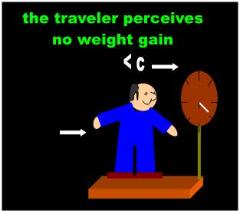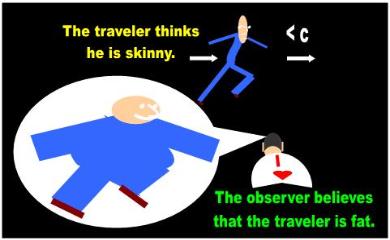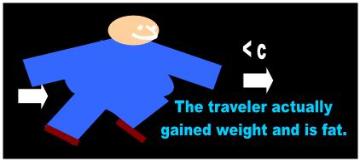If the conclusions of relativity regarding length are irrational, the predictions with respect to mass don’t
stay far behind. Relativists assert that the mass of an object increases at near-c velocities. The equation
relativists use to make this prediction is similar to the length contraction formula except that we substitute
relativistic mass and rest mass for their length counterparts:
- ________________________________________________________________________________________
- Last modified 01/15/08
- Copyright © by Nila Gaede 2008
| Adapted for the Internet from: Why God Doesn't Exist |
| Relativity has three physical interpretations for mass increase |
Fig. 1 The three interpretations relativists give to the mass increase equation |
The traveler notices no change in weight >
An observer and the traveler don’t agree on >
the weight they measure for the traveler.
The quantity of matter comprising an object >
actually increases.





| Relativity tests? There's nothin' to 'em! Just mark 'all of the above.' That's how I got straight A's in relativity when I was in college. |

| Easy Bill |
Like all equations in which infinities are involved, the mass equation conduces to either supernatural or
irrational results. In particular, it predicts that the ‘relativistic mass’ of an object will go to ‘infinity’ if it
manages to travel exactly at the speed of light. In a nutshell, relativists are saying that the amount in
question is larger than any amount that you can imagine. They are saying that the weight or force or
pressure exerted by the object on God’s bathroom scale would break it no matter what. I have already
discussed relativistic semantics at length in Chapter 1 and there is no need to regurgitate the entire list of
arguments against the adjective-turned-noun infinity, especially as it relates to mass.
Relativists offer at least three inconsistent physical interpretations of the meaning of the term mass
increase. Essentially, they can’t seem to make up their minds whether the effect is cosmetic (appearance,
perceptions) or real (increase in material substance) (Fig. 1). Depending on who you talk to in relativity, you
may hear one of the following physical interpretations for this supernatural claim:
• The traveler would experience no change in either the quantity of matter that comprises
- him or in inertia:
- “ The idea of mass increasing with velocity leads many to believe that the internal structure
of a quickly moving object is somehow altered. However, the standard view of relativity
is that the internal structure of an object is always unchanged, and that the different
quantities measured by different observers for energy and velocity are simply the same
reality seen from different points of view.” [1]
- “ Of course you wouldn’t feel uncomfortable… Motion itself doesn’t have any physical
effects, but it’s when you do a comparison with something else.” [2]
“ the increase in relativistic mass does not come from an increased number of atoms
in the object. Instead, the relativistic mass of each atom and subatomic particle has
increased.” [3]
- • A stationary observer and the traveler arrive at different values of inertia:
- “ Note that the body does not actually become more massive in its proper frame, since
the relativistic mass would be different for an observer in a different frame. The only
mass which is observer independent is the invariant mass. When using the relativistic
mass, one must always specify a velocity relative to a particular observer.” [4]
“ If one wishes to retain the notion that mass measures the ‘resistance’ to acceleration,
then mass can no longer be treated as a scalar quantity… In effect, an object would
have more mass in one direction than other [sic].” [5]
• The quantity of matter in a traveler increases. The following statements insinuate this if
- we take the word mass to mean ‘quantity of matter’:
- “ The mass increase of the relativistic space craft is real and absolute with the space
craft’s initial thrust providing the energy input to account for its absolute mass
increase.” [6]
“ as an object travels faster, its mass increases. But as the mass of an object increases,
it takes more and more energy to increase its speed any further. Eventually, as the
object gets close to the speed of light, it becomes so massive that no amount of energy
will make it go any faster. This means that the speed of light is a universal speed limit
which nothing with mass can break.” [7]
[So Bill? Why is that you say that relativists are a bunch of numskulls?]
- where Relativistic Mass is the mass of the object in motion
and Rest Mass is the mass of the object in an inertial frame of reference (i.e., stationary).
Therefore, like with length contraction, we have to determine which of these three scenarios the term
'mass increase' alludes to.
- Module main page: Mass confusion
Pages in this module:
1. This page: Relativity has three physical interpretations for mass increase
- 2. SR's massive definitions of mass
3. Mass is NOT quantity of matter
4. Quantum ‘predicts’ the existence of a unit of matter!
5. Rest mass is another way relativists have of saying relativistic mass
6. SR says that mass increases due to an increase in mass
7. Mathematical physicists have no idea what energy is
